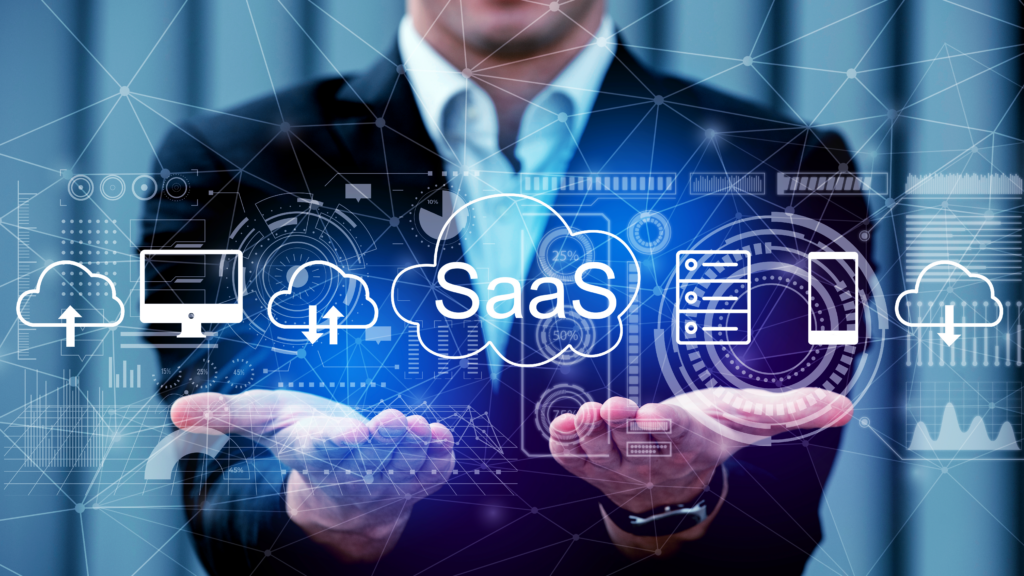We live in an era where the speed of technological innovation constantly redefines the way we conduct our business. And it is at the heart of this revolution that SaaS ( Software as a Service) .
It represents an approach that not only simplifies the delivery of software , but also transforms the way companies operate.
According to data from Grand View Research , the global SaaS market size was valued at US$261.15 billion in 2022 and is expected to grow at a compound annual growth rate of 13.7% until 2030 .
So, if you are still stuck with legacy systems, now is the crucial time to explore the possibilities of SaaS and unlock the full potential that the digital era has to offer.
In this article, we will provide practical insights software legacy into an agile, service-oriented solution. Get ready to discover how this transition boosts your company's innovation and competitiveness in the digital economy!
What is SaaS: an overview of software as a service
In the current context of information technology, SaaS is a model in which applications are offered over the internet, allowing remote access and a subscription structure .
Thus, this model allows companies to access tools and software software the need to install, maintain or update their own software Simplicity of access characterizes SaaS: users only need an internet connection to use the services.
What is the difference between SaaS and legacy software ?
SaaS is fundamentally different from software traditional software, known as software . While software generally requires installation, hardware and an initial license purchase, SaaS operates on a cloud-based , provided and managed by a third party .
This way, users have a subscription model that eliminates the need for large initial investments, offering software web -based . The key factor here is accessibility, as services can be accessed from anywhere, at any time, just with the internet.
How can SaaS impact your business?
Adopting the SaaS model in a business can revolutionize the way business applications are implemented and managed. For example, business applications like CRM (Customer Relationship Management) and ERP (Enterprise Resource Planning) are available as subscription services.
Thus, they become more accessible for companies of all sizes. This allows organizations to leverage solutions that were previously costly and complex to deploy.
The benefits of SaaS include reduced operational and capital costs, as responsibility for the IT infrastructure passes to the service provider. Cloud services offer scalability as business demands grow, without the burden of software and hardware .
Additionally, customization and continuous updates ensure that SaaS solutions stay up to date with the latest security functionality and compliance.
The main challenges of maintaining legacy software
Maintaining legacy software represents a series of challenges, from difficulties with documentation to issues of technological obsolescence. Problems can directly affect the security, performance and financial viability of an organization's operations.
Check out some of these challenges below:
Lack of adequate documentation
The lack of documentation makes maintenance and updates difficult , as the developers and engineers who take over the software they do not always have complete information about the original architecture or functionalities. This complicates the management of the entire IT infrastructure involved.
Security risks
Security risks are much greater in legacy software , as it often does not receive necessary updates that protect against newly discovered vulnerabilities. Ensuring robust security becomes a challenge as it compromises the integrity of the network and the data stored on servers.
High maintenance cost
The cost of maintaining old software is often high, as it requires specialists with specific knowledge, in addition to possible expenses with hardware to support the system. This makes the legacy system a loss compared to investing in more modern solutions.
Dependence on specific suppliers
Dependence on specific suppliers occurs when components, parts or even expertise for maintenance and support come from a single source , which creates service level agreement (SLA) problems and risks associated with service continuity.
Technological obsolescence
Technological obsolescence means that software may not be compatible with new technologies or market standards, isolating the company from innovations that could improve efficiency, performance and IT infrastructure management.
The benefits of adopting the SaaS model
As we have seen, adopting the SaaS model offers a series of advantages to companies, including operational agility, substantial reduction in IT costs, and the possibility of scaling resources according to demand.
Simplified maintenance and access to advanced technological resources are additional benefits that contribute to efficiency and competitiveness in the current market. See details below:
Agility and flexibility
SaaS-based systems are hosted in the cloud, which allows for quick deployment and access from anywhere. This means companies can adjust to new market conditions more quickly, adopting new applications or adjusting existing features almost instantly.
cost reduction
predictable cost structure is one of the advantages of SaaS. The subscription-based subscription model eliminates upfront infrastructure spending and reduces operational expenses, as there is no need for IT teams for system upgrades
Scalability
On-demand scalability is fundamental in the SaaS model. Companies can scale their use of software up or down easily depending on your current needs, allowing you to align more closely with demand and take advantage of economies of scale.
Simplified maintenance
SaaS users are always working with the most current version of the software , thanks to automatic updates managed by the service provider. This removes the complexity and responsibility of systems maintenance from the scope of the company's IT team.
Access to advanced features
SaaS offers access to services and technologies that would be costly or complex to implement independently. Thus, companies benefit from cutting-edge functionalities , such as data analysis and artificial intelligence, in an accessible way and without investing in hardware .
How to transform legacy software into SaaS?
Transform software Legacy in a SaaS solution involves a strategic process that requires detailed planning and careful execution to ensure that the software not only adapt to the cloud-based model, but also meet modern service expectations.
Check out some considerations about this process:
Feasibility assessment
This is the starting point software transformation legacy in SaaS. software must be considered current, its performance and how it fits into cloud paradigms. Cost-benefit analysis and compatibility with existing infrastructure are key to determining whether migration is viable.
Migration strategies
After evaluating feasibility, the next step is to define migration strategies. Therefore, it is crucial to opt for an approach that minimizes operational risks and disruptions. Some options include:
- Rearchitect: involves adjusting code for better performance in the cloud;
- Replatform: involves small modifications to adapt to the new environment;
- Rehost: involves migrating applications without any code modifications.
Safety
Security in the SaaS model is of utmost importance. Ensuring data protection in the cloud requires measures such as encryption , identity and access management, and constant updates to prevent vulnerabilities. Therefore, you need to choose a cloud provider that strictly complies with security and privacy standards.
Integration and APIs
Effective integration is the key to a successful SaaS, enabling the software communicate with other systems and services. The use of well-designed APIs facilitates this integration and opens up paths for expanding functionality. Employing middleware and ensuring compatibility with PaaS and IaaS are critical aspects for smooth integration.
Transform your software with Skyone
Now that you know the advantages of transforming your software legacy in SaaS, you need to know that we, at Skyone, are the ideal partners to carry out this transformation efficiently and safely!
cloud computing module features Skyone Autosky , which has everything you need to migrate, manage and orchestrate your software in the cloud safely – and without headaches!
Want to know more about our platform? Request a demo!
Conclusion
The SaaS model is increasingly becoming an efficient and scalable alternative for companies. As we have seen, the advantages include the flexibility of a subscription model, the significant reduction in infrastructure costs and the ease of updating and maintenance processes that are the responsibility of the supplier.
Subscribing to SaaS allows companies to offer a uniform and continuous service, providing a high level of customer satisfaction . Given market trends, the constant growth in preference for cloud , indicating a promising horizon for the future of SaaS.
In this context, take advantage and understand in depth how cloud migration processes work – as this is a very important factor in the success of your operation. Check out our complete guide!




